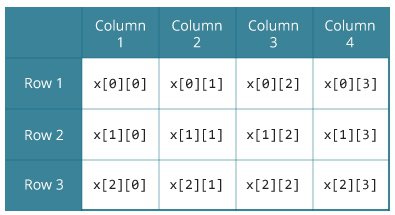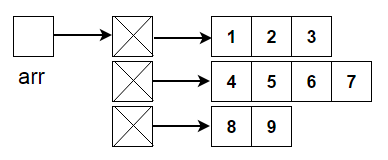Introduction
Arrays are powerful and flexible data structures and are particularly useful when we want to store and manipulate groups of similar data. However, arrays of Java are not confined to just one dimension. They can have two, three, or more dimtensions, allowing us to organise and manipulate more complex data structures. In this blog post, we’re going to take an in-depth look at two-dimensional (2D) and multidimensional array in Java.
Two-Dimensional Arrays In Java
A two-dimensional (2D) array, also known as a matrix, is essentially an “array of arrays”. In the context of Java, a 2D array is an array where each element is itself an array.
Let’s take a look at a practical example. Suppose we need to represent a simple grid of integers, like a game board or a table of data. A 2D array would be perfect for this:
int[][] grid = new int[5][5]; // a 5x5 gridWe’ve created a 5×5 grid, all initially filled with zeroes. We could picture this in our minds (or on paper) as:
0 0 0 0 0
0 0 0 0 0
0 0 0 0 0
0 0 0 0 0
0 0 0 0 0
We can access or modify an element of the grid using its row and column indices. For example, let’s set the element in the third row, fourth column to 7:
grid[2][3] = 7; // Arrays in Java are 0-based!
Our grid now looks like this:
0 0 0 0 0
0 0 0 0 0
0 0 0 7 0
0 0 0 0 0
0 0 0 0 0Traversing a Two-Dimensional Array
Traversing a 2D array is typically done with nested for loops – one loop for the rows and one for the columns:
for (int i = 0; i < grid.length; i++) {
for (int j = 0; j < grid[i].length; j++) {
System.out.print(grid[i][j] + " ");
}
System.out.println();
}This will print out the grid row by row.

Multidimensional Array In Java
Moving beyond 2D array, Java allows us to create arrays with three, four, or more dimensions. These are called multidimensional arrays. For example, suppose we’re creating a simulation of a 3D space – like a room in a video game or a volume of scientific data. A 3D array would be perfect for this:
int[][][] space = new int[10][10][10]; // a 10x10x10 cubeThis creates a 10x10x10 cube, again initially filled with zeroes. Visualizing a 3D array can be trickier, but you could imagine it as a stack of 2D grids.
Accessing and Modifying Elements in a Multidimensional Array
To access or modify an element in a 3D array, we need three indices – one for each dimension:
space[3][4][5] = 7; // set a specific point in our 3D space to 7Traversing a Multidimensional Array
Just like with 2D array, we traverse a 3D array using nested loops. This time, we need three levels of loops:
for (int i = 0; i < space.length; i++) {
for (int j = 0; j < space[i].length; j++) {
for (int k = 0; k < space[i][j].length; k++) {
System.out.print(space[i][j][k] + " ");
}
System.out.println();
}
System.out.println();
}This will print out the 3D space one 2D grid at a time.

Jagged Arrays In Java
While discussing multidimensional array , it’s important to touch upon a special type of array in Java known as a “jagged” array, also called a “ragged” array or an “array of arrays”.
A jagged array is a multidimensional array where the member arrays can be of different lengths, i.e., each row has a different number of columns. In other words, a jagged array is an array of arrays with variable length.

int[][] jaggedArray = new int[3][]; // Declare a 2D array with 3 rows
jaggedArray[0] = new int[3]; // First row has 3 columns
jaggedArray[1] = new int[2]; // Second row has 2 columns
jaggedArray[2] = new int[5]; // Third row has 5 columns
Here, jaggedArray is a two-dimensional array where each row can have a different number of columns. The first row has three columns, the second row has two, and the third row has five
We can visualize this array as follows:
1 2 3
4 5
6 7 8 9 10
You can also initialize a jagged array as follows:
int[][] jaggedArray = {
{1, 2, 3},
{4, 5},
{6, 7, 8, 9, 10}
};
Accessing elements in a jagged array is done in the same way as any other multidimensional array. However, you must be careful not to access an index that doesn’t exist in one of the sub-arrays. For example:
System.out.println(jaggedArray[1][2]); // Throws ArrayIndexOutOfBoundsExceptionThis will throw an ArrayIndexOutOfBoundsException because the second row (index 1) only has two columns (indices 0 and 1).
Traversing a Jagged Array
You can iterate over a jagged array in much the same way you would with a regular multidimensional array:
for (int i = 0; i < jaggedArray.length; i++) {
for (int j = 0; j < jaggedArray[i].length; j++) {
System.out.print(jaggedArray[i][j] + " ");
}
System.out.println();
}
When to Use Jagged Arrays
Jagged arrays are particularly useful in situations where your data is inherently “jagged”. For example, if you’re storing data that naturally falls into rows and columns, but not every row has the same number of columns, a jagged array might be the best solution. This can occur in situations such as storing the number of students in different classes in a school, or storing data about polygons in a graphic application where each polygon might have a different number of vertices.
Conclusion
Two-dimensional and multidimensional array in Java are powerful tools for managing complex data structures. While they can be more difficult to visualize and work with than one-dimensional arrays, they offer flexibility and functionality that make them indispensable for many programming tasks. Understanding how to create, manipulate, and traverse these multidimensional structures is a key skill for any Java programmer.
Jagged arrays, while a bit more complex than regular arrays, provide even more flexibility for storing and manipulating data in Java. Like all tools, they’re not always the right solution for every problem, but when used appropriately, they can make your code more efficient and easier to understand. Understanding how to create and use jagged arrays is a valuable addition to any Java programmer’s toolkit.

